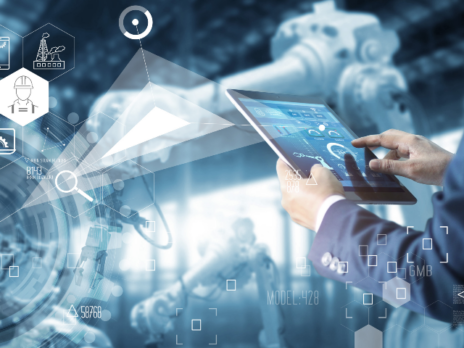
Industry 4.0 has been on the agenda for quite some time now, but its realisation is far from what fills our news feeds every day. So what is hindering the progress? Slow automation of manual sub-flows steps in the manufacturing processes.
Industry 4.0: The neglected challenge
At a nutraceutical production site, the operator Anna is responsible for the flow of material in process area A. She starts her shift by entering the material room to pick up the bucket labelled ‘tablet press A’, then walk the factory to ascend some stairs to reach a point approximately two meters higher up from where she can pour the powder into the funnel on top of the otherwise fully automated tablet press. She removes the lid and empties the bucket. The dust makes her sneeze. Still sneezing she descends the stairs, slips a little, but manages not to fall. At the bottom of the stairs, she presses the start button. Once the tablet press is complete, white tablets are ejected from the machine, landing in a container on the floor, which Anna seals and hands over to the next step in the process, the fully automated packaging line.
The solution
Anna is a fictitious person, but her situation seems to be commonplace in some industries. To achieve Industry 4.0, it is crucial to convert manual sub-flows into automated ones.
Piab is on a mission of Evolving Automation through progressive gripping, lifting and moving solutions, and their answer to the Industry 4.0 challenge is automating the transfer of powders and granules using vacuum technology. “We look at how to enhance productivity, safety and ergonomics at the customer site, how to do it in a SMART way and with ease of use in mind” – says Floris Rouw VP Sales Vacuum Conveying Division at Piab. “The latest innovation we have brought to simplify automation is our SMART vacuum conveyor, which using machine learning adjusts its performance based on material conveyed and the environment at the site”.
For the situation described above, both the inflow (the powder) and the outflow (the finished tablets) can be solved using a semi (conventional solution) or a fully automatic vacuum conveying system (controlled by machine learning), where human interaction becomes minimal as the system itself can adapt to the humidity, as well as the density of the material.
By moving from a manual flow to an automated one, the fundamental prerequisites are being established for generating relevant data and linking up the complete system, leaving no manual ‘black-box’ islands behind. In Anna’s case, it would also lead to less exposure to dust, as well as reducing the safety and ergonomic risks attached to her handling the material manually. The result is increased productivity and an improved working environment.
To a great extent, the next few years will be spent transforming manual sub-flows into automatic ones that generate relevant data and link up to form a unit, focusing on the overall optimisation rather than that of each part. Efforts will focus on upgrading semi-automated flows into fully automated solutions based on minimal physical human interaction. Not until that happens will we be able to talk about Industry 4.0 and its potential for the processing industry. What it boils down to is understanding and investing in the weakest link, because that is what is stopping your company from reaching the full potential of Industry 4.0.



